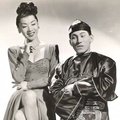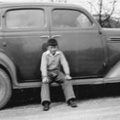Piece by piece, clue by clue, the big picture is coming together.
Patched together from black and white photos, diaries and letters, the missing history of the Japanese-American internment on Kauai during World War II is starting to fill.
More light is being shed, thanks to intensive research.
In the ongoing effort to update the available information, the Kauai Museum announced recently that five years of research has culminated in a major update to the exhibits related to the war years of 1941-45. Five years of research on the internment experience has resulted in the most complete information available on individual detainees to date.
“This is history and so what is important here is to understand what happened to these people,” said Roy Miyake, a volunteer researcher with the Kauai Museum. “If you understand that then you can understand why history happened the way it did.”
Kauai Museum started the study in 2008 as research for the exhibit. Miyake sifted through 10,000 records of internees sent to war relocation centers.
The study is limited to people born on Kauai or people who were on Kauai at the time of their detainment. It also includes a dozen people born on Kauai but were in California when they were sent to the camps.
The Japanese population of Hawaii was around 140,000 in 1941, with a total population of around 500,000 on all islands. Around 1 percent, or 1,441 Japanese, were detained, to include 879 aliens, 534 citizens and 28 expatriates, according to the Kauai Museum.
Around 36 percent of Kauai’s 36,000 population were Japanese in 1940. The museum notes that the internment timeline began the day of the Pearl Harbor attack on Dec. 7, 1941, and lasted through 1944.
Around 106 individuals are documented as interned on Kauai, with around 100 more family members going into voluntary internment to keep families together or with no other option.
“We think that we have identified 90 to 95 percent of the people and there are a few more out there we don’t know about,” Miyake said.
The part-time project took hundreds of hours of research. Most was done online with the Library of Congress and written records at the University of Hawaii. They also viewed every Garden Island issue from 1938 to 1945.
The possibility that many more people who were detained briefly but released with no written record is strong, he added. The project is unfinished.
“For the people that were physically sent to a war relocation center or a Department of Justice camp, there is a record somewhere in the archives,” Miyake said.
Detaining on Kauai
There were four internment processing centers on Kauai. The earliest detainees were community leaders on an FBI list in the days and weeks following Pearl Harbor. They were brought to the Waimea jail with its three cells; the old county jail with a barracks built behind it with showers and dining facilities; and Isenberg gym on the Lihue Plantation.

One Kauai Japanese American resident was held for several months in the shower room of the Lihue Plantation “Isenberg” gymnasium before being sent to Sand Island for detention on Oahu. The building still stands as a church property about one block from the Lihue Neighborhood Center.
The Kalaheo Stockade wasn’t set up until March 1942 when the Army came to Kauai. It was built on Medeiros Chicken Farm land to house military prisoners and became a long-term internment facility. It is no longer standing and there is still debate as to its location. It was illegal for anyone but the Signal Corps to take photos of it.
Betsy Fujii Young, a staff associate with the Japanese Cultural Center of Hawaii, said that witnesses described the Kalaheo Stockade as wood barracks with green paint. The barracks were built on posts in the plantation style with steps and no porches.
The search for Kalaheo stockade began in 2006 with a former internee and a retired national park archeologist.
“There were no maps or documentation at the time and the search was not conclusive,” Young said.
They had better luck in 2012 with Wayne Jacinto and Wayne Rapozo leading the group, she said. Without permission to access the actual location, they scouted from a hill above and verified the site using a description provided by Vergie Rapozo, who reported watching the camp from that spot as a child.
“Most of the original internees have passed on and their children are now telling the stories,” she said.
A National Parks Service grant in 2010 awarded $117,626 to JCCH to produce the documentary video The Untold Story on the Hawaii internment for use in schools. The film depicts the Kalaheo Stockade along with the Isenberg gym and other sites on the islands.
Hawaii was preparing for the country’s possible war with Japan prior to Pearl Harbor with a Civil Defense plan. The plantations were managed like a military organization, said Kauai Museum Collections Curator Chris Faye.
More than a decade before the war, the FBI was putting together custodial lists of people they thought to be enemies of the state should war occur with Japan. If they were on the list, then they were almost always shipped to a Mainland internment camp, Miyake said.
Until the Battle of Midway, people thought Hawaii was going to be invaded and there was a lot of fear, Faye said. Plantation managers sent their wives and children to the Mainland.
“Stray animals were shot because people were scared at night thinking they were the Japanese,” she said.

Kauai Museum Curator Christine Faye in front of the updated Kauai World War II and Japanese American Internment exhibits.
Most of the Kauai internees that were sent to the Mainland went to Santa Fe, said Miyake. People are now coming forward with photos and diaries that are providing information about others who were there.
When someone is identified, they try to put together a larger picture with other available information.
Filling in the pieces
In early 2013, someone contacted the museum with two group photos with 62 people without names at the Santa Fe camp. After showing the photos at Japanese community events they have since identified 42 people, he said.
It is a beautiful thing when people with fading memories suddenly recall that the old man in the photo was their Japanese language teacher or minister, he said.
“They were the community leaders,” he added.
The military shut down all 22 language schools and 14 other cultural associations on Kauai. Eight of 19 Buddhist temples were dissolved and five more were closed, leaving four licensed to operate and two in question.
Miyake said his father was tasked with Americanizing the Japanese population. This meant speaking English, not using chopsticks or wearing kimonos.
Miyake’s father’s was Noboru Miyake (1896-1988), the first Japanese resident to hold public office in Hawaii on the Kauai Board of Supervisors. He was forced to resign at the start of the war and volunteered to serve on the Kauai Morale Committee with Masato Sugihara, Chas Ishii, Masao Yamada, Kazuichi Hirano, Masaru Shinseki, Samuro Ichinose and Saburo Kawakami.
The museum exhibit notes that Japanese community morale was low and the group was directed by the Kauai Civil Defense to provide outreach concerning blood drives and volunteer work for the military.
“A lot of it is a combination of racial prejudice combined with war hysteria that is reflected in illogical behavior and decision-making on the part of the President to the United States, if you want to go that far,” Miyake said.
The question was about loyalty and duty and there were no reports of Japanese American sabotage, he said. The lasting message from this project is a realization that more documentation is needed to understand what happened.
The FBI was creating a custodial detention of Japanese in Hawaii since the 1930s, he said. Anyone who was associated with the Japanese consulate was on the list even for just helping someone to fill out a form.
Miyake said he looked at occupations and noted that many were Kibei, or Hawaiian born Japanese that were educated in Japan. They were language school teachers and ministers or had some connection to the Japanese consulate.
President Roosevelt could not forcefully relocate all of them to the Mainland, Miyake said, because it would have devastated the wartime plantation economy.
Miyake said the Kauai sites were temporary processing points and should not have the same designation as Mainland internment camps that held thousands of people for the duration of the war.
“The point is that any place where someone was held does not meet the level of an internment camp,” Miyake said.
The archives at the Library of Congress does list Kalaheo as a stockade and an internment facility on Kauai, he said, but in reality it was built to hold military prisoners after the Army came in 1943. It was a convenient place to hold Japanese Americans when the order came and the jails filled up fast.
Carole Hayashino, president and executive director of the Japanese Cultural Center of Hawaii, said the results of a special resource study from the National Park Service will determine what recognition will be granted the five main camps in Hawaii. She is hoping for special historical significance to the longest running Honouliuli Internment Camp in West Oahu.
The Kalaheo story is similar to the other camps that were on private land, she said. They slowly disappeared and the lack of documentation makes it difficult to put the history together.
“I find that on every island county the sites are unique and different,” she said. “That is why the research being done by the Kauai Museum and KCCH is very important and we want to document and capture this history that is so special to each specific site.”
Hayashino said the more people that come forward with stories and photos, whether internees or their descendants and even the guards or their children, can help document the history.
This is an untold story of Hawaii, she said. People were taken and humiliated and then had to pick up the pieces and move on with their life.
“There was an impact on the individual and on the community,” she said.
* This article was originally published on The Garden Island on November 24, 2013.
© 2013 The Garden Island / Tom LaVenture





